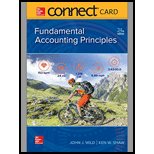
Connect Access Card For Fundamental Accounting Principles
24th Edition
ISBN: 9781260158526
Author: John J Wild
Publisher: McGraw-Hill Education
expand_more
expand_more
format_list_bulleted
Concept explainers
Textbook Question
Chapter 20, Problem 5APSA
Problem 20-5AA FIFO: Process cost summary: equivalent units; cost estimates C3 C4 P4
Refer to the data in Problem 20-4A. Assume that Tamar uses the FIFO method to account for its
- Beginning work in process consisted of 3,000 units that were 100% complete with respect to direct materials and 40% complete with respect to conversion.
- Of the 22.200 units transferred out. 3,000 were from beginning work in process. The remaining 19,200 were units started and completed during May.
Required
1. Prepare the Forming department's process cost summary for May using FIFO.
Check (1) EUP for conversion, 22,920
2. Prepare the
(2) Cost transferred out. $2.667.840
Expert Solution & Answer
Want to see the full answer?
Check out a sample textbook solution
Students have asked these similar questions
Margin % this year investment opportunity?
I want to correct answer general accounting question
What is the margin % related to this year's investment opportunity?
Chapter 20 Solutions
Connect Access Card For Fundamental Accounting Principles
Ch. 20 - Prob. 1DQCh. 20 - Prob. 2DQCh. 20 - Prob. 3DQCh. 20 - Prob. 4DQCh. 20 - Prob. 5DQCh. 20 - Explain in simple terms the notion of equivalent...Ch. 20 - Prob. 7DQCh. 20 - Prob. 8DQCh. 20 - Direct labor costs flow through what accounts in a...Ch. 20 - Prob. 10DQ
Ch. 20 - Prob. 11DQCh. 20 - Prob. 12DQCh. 20 - Prob. 13DQCh. 20 - Companies such as Apple commonly prepare a process...Ch. 20 - Prob. 15DQCh. 20 - Prob. 16DQCh. 20 - Prob. 17DQCh. 20 - How could a company manager use a process cost...Ch. 20 - Explain a hybrid costing system. Identify' a...Ch. 20 - Prob. 1QSCh. 20 - Prob. 2QSCh. 20 - Process vs. job order operations C1 For each of...Ch. 20 - Physical flow reconciliation C2 Prepare a physical...Ch. 20 - Prob. 5QSCh. 20 - A FIFO: Computing equivalent units C4 Refer to QS...Ch. 20 - Prob. 7QSCh. 20 - Prob. 8QSCh. 20 - Prob. 9QSCh. 20 - Prob. 10QSCh. 20 - Prob. 11QSCh. 20 - Prob. 12QSCh. 20 - Prob. 13QSCh. 20 - Prob. 14QSCh. 20 - Prob. 15QSCh. 20 - Prob. 16QSCh. 20 - A FIFO: Journal entry to transfer costs P4 Refer...Ch. 20 - Prob. 18QSCh. 20 - Weighted average: Assigning costs to output C3...Ch. 20 - Prob. 20QSCh. 20 - Prob. 21QSCh. 20 - Prob. 22QSCh. 20 - Recording costs of materials P1 Hotwax mates...Ch. 20 - Prob. 24QSCh. 20 - Recording costs of factory overhead P1 P3 Prepare...Ch. 20 - Recording transfer of costs to finished goods P4...Ch. 20 - Exercise 20-1 Process vs. job order operations C1...Ch. 20 - Exercise 20-2 Comparing process and job order...Ch. 20 - Prob. 3ECh. 20 - Prob. 4ECh. 20 - Prob. 5ECh. 20 - Prob. 6ECh. 20 - Prob. 7ECh. 20 - Exercise 20-8 Weighted average: Computing...Ch. 20 - Prob. 9ECh. 20 - Prob. 10ECh. 20 - Prob. 11ECh. 20 - Prob. 12ECh. 20 - Exercise 20-13A
FIFO: Completing a process cost...Ch. 20 - Exercise 20-14 Production cost flow and...Ch. 20 - Exercise 20-15 Recording product costs P1 P2 P3...Ch. 20 - Prob. 16ECh. 20 - Prob. 17ECh. 20 - Prob. 18ECh. 20 - Prob. 19ECh. 20 - Prob. 20ECh. 20 - Prob. 21ECh. 20 - Exercise 20-22 Recording costs of labor P2 Prepare...Ch. 20 - Prob. 23ECh. 20 - Prob. 24ECh. 20 - Exercise 20-25 Recording cost flows in a process...Ch. 20 - Exercise 20-26 Interpretation of journal entries...Ch. 20 - Prob. 1APSACh. 20 - Prob. 2APSACh. 20 - Prob. 3APSACh. 20 - Problem 20-4A Weighted average: Process cost...Ch. 20 - Problem 20-5AA FIFO: Process cost summary:...Ch. 20 - Prob. 6APSACh. 20 - Prob. 7APSACh. 20 - Prob. 1BPSBCh. 20 - Prob. 2BPSBCh. 20 - Prob. 3BPSBCh. 20 - Prob. 4BPSBCh. 20 - Problem 20-5BA FIFO: Process cost summary;...Ch. 20 - Problem 20-6BAFIFO: Costs per equivalent unit;...Ch. 20 - Problem 20-7BA FIFO: Process cost summary,...Ch. 20 - Prob. 20SPCh. 20 - Prob. 20CPCh. 20 - Prob. 1GLPCh. 20 - Apple has entered into contracts that require the...Ch. 20 - Apple and Google work to maintain high-quality and...Ch. 20 - Prob. 3AACh. 20 - Prob. 1BTNCh. 20 - Prob. 2BTNCh. 20 - Many companies use technology to help them improve...Ch. 20 - Prob. 4BTNCh. 20 - Prob. 5BTNCh. 20 - Prob. 6BTN
Knowledge Booster
Learn more about
Need a deep-dive on the concept behind this application? Look no further. Learn more about this topic, accounting and related others by exploring similar questions and additional content below.Similar questions
arrow_back_ios
SEE MORE QUESTIONS
arrow_forward_ios
Recommended textbooks for you
 Cornerstones of Cost Management (Cornerstones Ser...AccountingISBN:9781305970663Author:Don R. Hansen, Maryanne M. MowenPublisher:Cengage Learning
Cornerstones of Cost Management (Cornerstones Ser...AccountingISBN:9781305970663Author:Don R. Hansen, Maryanne M. MowenPublisher:Cengage Learning Managerial AccountingAccountingISBN:9781337912020Author:Carl Warren, Ph.d. Cma William B. TaylerPublisher:South-Western College Pub
Managerial AccountingAccountingISBN:9781337912020Author:Carl Warren, Ph.d. Cma William B. TaylerPublisher:South-Western College Pub Managerial Accounting: The Cornerstone of Busines...AccountingISBN:9781337115773Author:Maryanne M. Mowen, Don R. Hansen, Dan L. HeitgerPublisher:Cengage Learning
Managerial Accounting: The Cornerstone of Busines...AccountingISBN:9781337115773Author:Maryanne M. Mowen, Don R. Hansen, Dan L. HeitgerPublisher:Cengage Learning- Principles of Accounting Volume 2AccountingISBN:9781947172609Author:OpenStaxPublisher:OpenStax College

Cornerstones of Cost Management (Cornerstones Ser...
Accounting
ISBN:9781305970663
Author:Don R. Hansen, Maryanne M. Mowen
Publisher:Cengage Learning

Managerial Accounting
Accounting
ISBN:9781337912020
Author:Carl Warren, Ph.d. Cma William B. Tayler
Publisher:South-Western College Pub

Managerial Accounting: The Cornerstone of Busines...
Accounting
ISBN:9781337115773
Author:Maryanne M. Mowen, Don R. Hansen, Dan L. Heitger
Publisher:Cengage Learning

Principles of Accounting Volume 2
Accounting
ISBN:9781947172609
Author:OpenStax
Publisher:OpenStax College
Cost Accounting - Definition, Purpose, Types, How it Works?; Author: WallStreetMojo;https://www.youtube.com/watch?v=AwrwUf8vYEY;License: Standard YouTube License, CC-BY